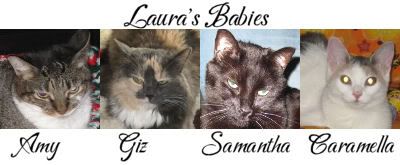As most of you know, I have been very disturbed by Amy's worsening condition with her CH.. I guess I locked in on the words the condition don't get any worse and that is what I expected. Well, while I am waiting for the sweet potato pies to bake, I been surfing the web, looking for ANYTHING that would help me.... I found this and I guess this is what I been looking for and explaines it. I was ready to pack her up and take her out of state to a specialist to help find a answer to her worsening condition. See what I have put in bold...
(Just makes me want to CRY!.... and I have)
Cerebellar Hypoplasia
The cerebellum is the portion of the brain responsible for the control of motion. When a puppy or kitten is born with an underdeveloped cerebellum, the condition is known as congenital cerebellar hypoplasia. There are infectious causes of this condition in both cats (panleukopenia infection prior to birth) and dogs (herpes virus infection prior to birth). Improper development of the cerebellum may occur due to injury, poisoning or just from an accident in development in the uterus. It is generally possible to see signs of this condition almost as soon as the puppy or kitten is born. Affected animals have tremors and unusual jerky movements or may fall down when they try to move. The symptoms do not get worse as they age. As the kitten or puppy grows it will learn to compensate for its condition but there are usually lifelong signs of a decreased ability to coordinate movement. Almost all dogs and cats with congenital cerebellar hypoplasia can live happily as pets with a little special care to compensate for their disabilities. This condition can be confused with cerebellar abiotrophy, a different disorder in dogs in which the puppy has a normal cerebellum at birth but it gradually dies. Signs of disease identical to cerebellar hypoplasia occur but the timing is different. Puppies with this condition seem normal at birth but usually start to show signs of problems after they are 2 months or more of age.







 Reply With Quote
Reply With Quote
Bookmarks